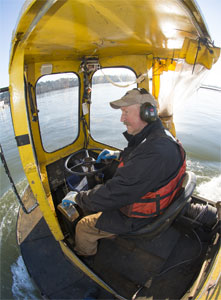Martin Anderson has been helping put together and take apart log booms on the coast of British Columbia for 40 years. He does this from the deck of a Sidewinder boom boat that has been ubiquitous in the West Coast maritime scene since the 1960s.
Anderson’s current employer, Pacific Custom Log Sorting Ltd., operates a fleet of 10 of these Sidewinders. With hulls only 18 feet long, the boats have an 8-foot beam and 3.5-foot molded depth from the deck to the chine of the nearly flat-bottomed hull. On deck, a raised engine hatch combing gives added freeboard while providing additional engine room space. Extending just over 30 inches below the hull’s bottom, a stout steel cage protects the single forward-mounted Olympic z-drive unit that, together with a 3-foot-deep-by-6-foot-long aft-mounted skeg, gives the Sidewinder its distinctive handling characteristics.
Recently another of the company’s senior operators, Mark Kurucz, demonstrated the apparently simple operation of the boat. In a pilothouse set well up on the bow of the boat, the operator has a single lever to engage the engine with the z-drive, a throttle control and a horizontally mounted automotive-type steering wheel. A steel knob, of a sort common in cars before power steering, is clamped on the rim of the black steering wheel. Kurucz grasped it and turned the wheel so that the knob was toward the bow, then spun the wheel 180 degrees so that the knob was toward the stern. “That’s it,” Kurucz said, “forward and reverse, wherever the knob is pointing the boat will go.”
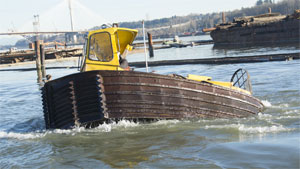 |
|
A 45-degree turn of the wheel from full-ahead rotates the azimuthing drive and bucks the vessel to starboard. |
After that, things get a bit more complex. Running down the bow and extending well below the hull depth, a set of log teeth bite into and hold a log in position. Four other sets of log teeth are welded down the side of the hull, two each to port and starboard just on the curve of the bow. These teeth point both fore and aft for improved grip on the logs. In practice, the operator is out of the boat nearly as much as he is aboard. Working alone, Kurucz said, he uses a bungee cord to hold the wheel in position for the boat to be angled to a log so that the log teeth hold it in position. A second bungee cord holds the throttle at idle while he jumps onto the log in his caulked rubber boots to set or release a swifter wire or boom chain.
Introduced in the late 1950s, the first of these little boats employed a center-mounted 360-degree rotating outboard motor. Called “Log Broncs,” they were designed to aid in the building of log booms that are used to tow logs from coastal operations. Anderson started his Sidewinder career up the coast in Jervis Inlet. Typical of coastal inlets, Jervis is flanked by towering mountain peaks that catch the rain to grow the forest while making road-building prohibitive. Loggers have used the side valleys to access timber, which is then dumped into the sea, sorted and bundled with wire swifter-cables for the tow to the lower mainland. Other operations on Haida Gwaii or the west coast of Vancouver Island make similar bundles that are loaded onto log barges for transport across open water then dumped in Howe Sound, near enough to the mills to be the boomed and towed.
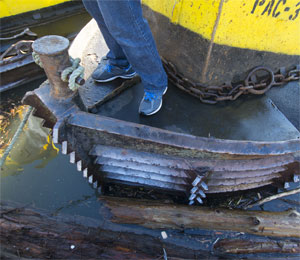 |
|
Serrated teeth fore and aft allow the powerful little boats to move logs rapidly into booms. |
In operations such as Pacific Custom Log Sorting, the booms are taken apart and the sorted logs are sent on to their buyer’s destination. This can be one of the many sawmills along the lower Fraser River or to the Fraser-Surrey docks for loading onto an Asian-bound freighter.
Tugs have been described as powerful engines wrapped in a steel hull, and this is certainly an apt description of these little boom boats. Each boat has a single Detroit Diesel 6-71 engine producing about 220 hp and mounted with the drive end facing forward to the z-drive. These classic Detroit Diesel two-stroke 71 series engines, including the V series, had 71-cubic-inch displacement cylinders. The 6-71 was introduced in 1938. Adopted by the U.S. Navy for installation in landing craft and manufactured in both the U.S. and, under license, in Russia the 6-71s were built in the thousands. After World War II there were huge inventories of the engine declared surplus and they gained wide acceptance in the North American marine world. Thousands more were built until they were replaced by a four-stroke engine in 1995.
Noted for the sound that earned them the “screaming Jimmy” name, they are equally noted for their ease of maintenance. Iouri Glebov maintains Pacific Custom Log Sorting’s fleet of 10 Sidewinders and, if necessary, can change out an engine at the company shop and have the boat back in the water the same day.
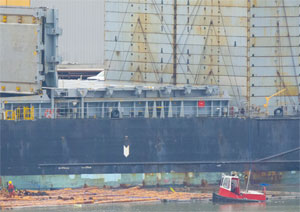 |
|
In one of many applications, a Sidewinder helps longshoremen load logs onto a freighter at the Fraser-Surrey docks. |
With their single forward-mounted drive, the Sidewinders are not very good at towing logs, but they are highly maneuverable and can shepherd logs and bundles of logs into place in a boom with the speed of a border collie herding sheep. Other work includes breaking and building bundles. This is where their sidewinding winch comes into play. Most of the boats have a small Pullmaster hydraulic winch mounted on the starboard side just ahead of the engine cover and just aft of the operator’s seat. Loaded with 1/4-inch wire, it pays out over the boat’s port side through a fair lead. When tightening a swifter wire on a log bundle, the operator can leave the boat and pull the wire across the logs, set it, return to the boat and wind it in before taking an ax and staple to dog the wire down when tightened.
When a World’s Fair was held in Vancouver in 1986, the Rivtow tug company developed a performance in which four of its Sidewinders did a Boom Boat Ballet. However, as agile as the little boats are, their operators, dancing as they do from boat to boom, are required to be every bit as agile as their boats. The British Columbia coast is notorious for its rain. Logs, especially those without bark, can be very slippery. These mariners use rubber boots with caulks screwed into metal settings in their soles. With safety a priority at the log-sorting ground, everyone wears a life jacket but it is the boots that serve as the front line in preventing dunkings.
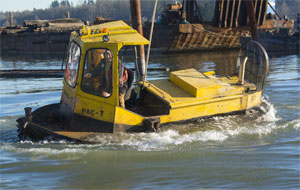 |
|
A 180-degree turn of the wheel automatically rotates the drive and dodges the deep-hulled boat to port. |
The 10 yellow Sidewinders at Pacific Custom Log Sorting, like their operators, have come from various coastal places and have been built by a variety of builders. Today, demand for this class of boom boat continues. Campbell River’s MacTavish Welding and Canadian Alberni Engineering, among others, have been building them for decades and continue to meet orders.
“In the 20 years that I have been here, we have stayed with our standard 18-by-8-by-6-foot-4-inch hull,” said Steve Dunagan of Alberni Engineering. “We put in whatever make of engine the customer requests but we stay right around 200 hp. This is well matched to the Olympic HD3 drive with a 27-inch four-blade prop that we use.”
The design of offshore tugs, like most commercial boats, has undergone some significant changes in the past 50 or 60 years. At the same time, the hull form and drive systems of the Sidewinders have remained remarkably consistent. For operators like Anderson at Pacific Custom Log Sorting, even the Detroit 6-71 remains consistent. Clearly, the ubiquitous Sidewinder, to be found working logs in British Columbia, is one of those rare near-perfect designs.

